
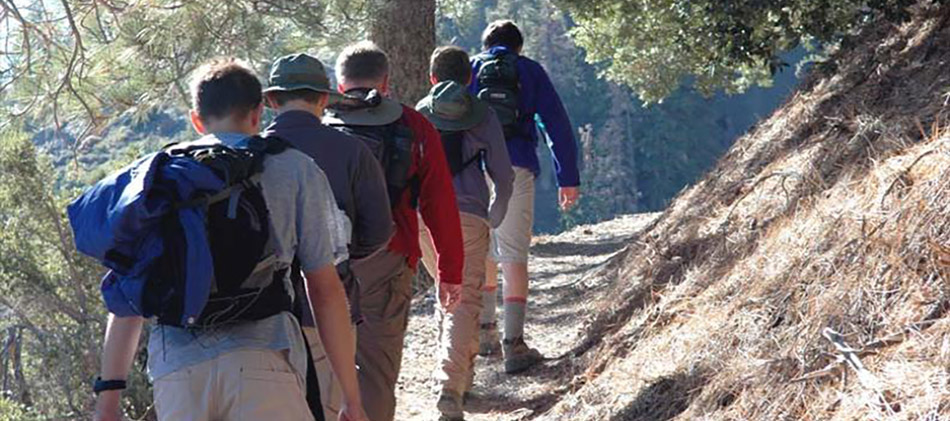 Outdoor Conditioning
Outdoor Conditioning Most conditioning books and training videos that I have read and seen out there are so involved and require such a wide range of exercises and activities, that you would have to quit your job and work at it full time to meet the various conditioning requirements in them. Here at Timberline Trails, we would like to present you with some important information that will allow you to get the best trade off when it comes to time spent and conditioning results.
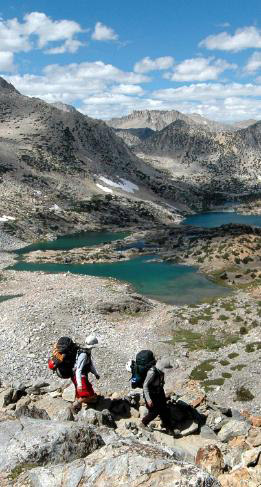 One of the many questions I get here at Timberline Trails, is how do I get started in mountaineering. I usually reply by letting them know that the first thing they need to do is get in shape if they have not done so already. I have found that most people fail to make their goals of gaining a summit or getting to their destination on a hike or backpack not because of their lack of technical skills, but because of poor aerobic fitness.
One of the many questions I get here at Timberline Trails, is how do I get started in mountaineering. I usually reply by letting them know that the first thing they need to do is get in shape if they have not done so already. I have found that most people fail to make their goals of gaining a summit or getting to their destination on a hike or backpack not because of their lack of technical skills, but because of poor aerobic fitness. This is not to say that the mental and technical aspects are not important when it comes to making an actual climb, but I say the above because the mental and technical skills do not even come into play if you burn out and call it quits down low on the trail somewhere. I can tell you from experience that being out of shape and going into the mountains is an exercise in pain at best. Things are difficult enough out there (even when you are in shape), so why add to it by being in poor condition.
Training must be very specific to the activity you plan on engaging in, and when it comes to mountaineering, nearly every muscle group in your entire body will come into play. Our bodies are both physiological (cardiovascular) and bio-mechanical (musculoskeletal) structures. Optimizing this incredible machine requires proper conditioning and training.
No matter what subject I am studying, I like to be presented with the "how do things work" approach. I find that understanding the "whys" helps me when it comes to the actual "doing." It's kind of like a parent telling his or her very young child "don't touch the hot stove." If they ask why and you tell them ..."because I told you so" ... You just may end up in the local emergency room tending a third degree burn on your youngsters hand. But if you sit down and explain the ins and outs of scalding heat and the possible resultant injuries it can produce, they just may listen and heed your advice. So that being said, let's get started with some basic physiological science. Aerobic vs Anaerobic
To put it simply, aerobic exercise, is when the body has sufficient oxygen available to supply the muscles. Activities such as hiking, cycling, easy paced jogging, cross country skiing and such, are examples of aerobically fueled activities. But as the pace quickens, the heart begins to beat faster, and the breathing rate increases, in order for the lungs and heart to be able to deliver the increased demand of oxygen to the targeted muscles. But there comes a point where the heart and lungs cannot keep up, and the body switches to the anaerobic (without oxygen) energy pathway to sustain the demand being placed on it. Examples of this would be when you sprint, cycle up hill, or go through a sequence of very difficult moves when climbing. Aerobic movement can be sustained for long periods of time, whereas anaerobic activities cannot be sustained for long periods of time.
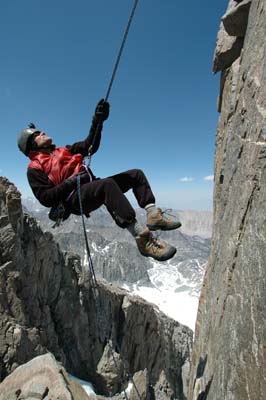 So how long can intense activity be maintained? Well, to understand this, you need to know
about things like ATP, CP, and lactic acid threshold. ATP (adenosine triphosphate) and CP
(creatine phosphate) are the first energy sources the body uses when subjected to intense
exercise. The body stores only very small amounts of ATP (100 grams) in the cells, and
thus it is used up very quickly. It is only able to sustain about 5 seconds of very intense
activity, and usually no more than 15-20 seconds at best. This would be good for a bold
move over a very hard climbing section, or sprinting in a hundred or two hundred meter
race. But after this energy source is used up, the body switches to an energy source known
as glycolysis.
So how long can intense activity be maintained? Well, to understand this, you need to know
about things like ATP, CP, and lactic acid threshold. ATP (adenosine triphosphate) and CP
(creatine phosphate) are the first energy sources the body uses when subjected to intense
exercise. The body stores only very small amounts of ATP (100 grams) in the cells, and
thus it is used up very quickly. It is only able to sustain about 5 seconds of very intense
activity, and usually no more than 15-20 seconds at best. This would be good for a bold
move over a very hard climbing section, or sprinting in a hundred or two hundred meter
race. But after this energy source is used up, the body switches to an energy source known
as glycolysis. This is good for up to three minutes or so, depending on your condition level, because high levels of lactic acid are produced as a by-product of burning this type of fuel. Glycogen (or glycolysis) is stored in the muscles, and can be quickly broken down into glucose. But as mentioned above, lactic acid is also produced as a by-product, and this produces a very acidic environment for your muscles, and they do not function well at all when they are immersed in an acid bath. If intense activity continues the muscles will come to a screeching halt if you continue to push them without giving them the needed break, by either lessening the pace, or stopping all together.
This is known as the "lactic threshold," a point at where the muscles can no longer sustain intense activity due to the lactic acid that has been produced. This is where conditioning comes in big time. This is because this threshold can be raised if you are in very good condition. But nevertheless, everyone will hit their level at some point, and the body will then need to rest or slow down in order to neutralize the resultant lactic acid.
This is not to say that lactic acid is not produced during aerobic exercise, because it is. But it accumulates at a far slower rate, and that is why you can sustain aerobic activities for extended periods of time. Being in condition will enable you to hike or climb for possibly several hours longer than you could if you were in poor condition. This is because the bodies of fit individuals build up lactic acid at a much slower rate, and they can also gain the ability to dissipate the lactic acid at a faster rate than unfit folks.
NOTE:
Not only is acid buildup in the system bad for muscle function (as mentioned in the text to the left), but it is also bad for the body in general. Even though lactic acid is a natural by-product of intense exercise (which has it's wonderful benefits), there is a flip side to this, and that is to intentionally create an acidic environment for your body by the things you eat. This, obviously, is not a good thing. Eating highly processed foods and high sugar items such as soda pop and the like, are very acidic in nature, and are thus damaging to your health. They only serve to prematurely age you and put you at risk for all sorts of degenerative diseases. On the other hand, eating high quality fruits and vegetables (try to go heavier on the vegetables) help alkalize the body and neutralize the acid in the system. So eat as much natural foods as possible and stay away from the junk food. You will feel much better, and have far greater energy if you do.
Disclaimer: The above is for the day to day routine when it comes to proper nutrition. In the "Climbing Food" section of Timberline Trails, there is talk of pop tarts and other junk food type fuel. This is because in the mountains it is often difficult to get anything down, and you need fuel anywhere you can get it. (And it gets burned off very quickly anyway).
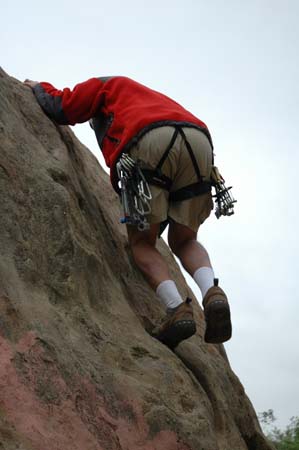 DEPLETION OF GLYCOGEN –
DEPLETION OF GLYCOGEN –Steady long term exercise will eventually deplete your stored glycogen. When this happens you hit the "infamous wall." But with good pacing, proper on the go nutrition, and a short break now and then, you should be able to go all day.
LOW BLOOD GLUCOSE -
Blood glucose is one of the possible fuel sources for working muscles, but it is the only fuel source available for the brain and nervous system. As glycogen supplies dwindle working muscles become increasingly reliant on blood glucose for fuel. As a result, blood glucose levels drop and increasing levels of exhaustion and mental fatigue set in. This can impair coordination, concentration, and your ability to perform difficult motor skills. Bompa states that nerve cells take seven times longer to recover than muscle cells. Thus, several days may be required for a complete recovery after extended exercise. MUSCLE CRAMPS Muscle cramps are caused by microscopic muscle tissue tears and accompanying tightness and swelling. Strength will be diminished for as long as the pain persists. So if you find yourself sore, take the time necessary for a complete recovery during your conditioning routine. You will gain strength and endurance faster if you do so.
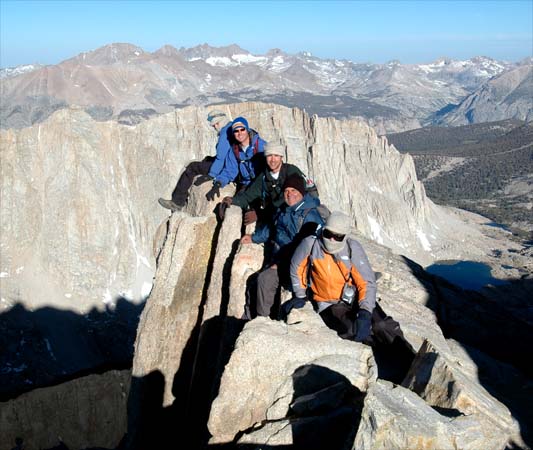 SPECIFICITY
SPECIFICITYThe principle of specificity of training is a concept that simply states this: You will increase your performance in any sport by training in a way that most closely mimics your intended activity. This is incredibly important to get a handle on, and you will soon see why this is the guiding principle behind nearly every training decision.
GETTING DOWN TO BUSINESS
So what is the most effective way to get into shape? Well, that depends on what type of activity you want to excel at. Since this is a site on hiking, climbing, and mountaineering, we will concentrate on those activities, and leave the rest to other books, and web sites.
So, for hiking or backpacking to the top of Mt Whitney on a trail for example, you will want to concentrate on aerobic conditioning. For those of you who are uninterested in long duration type activities, other hand, need to be proficient in both endurance activities such as hiking and backpacking (in order to get to the base of the peak), and climbing(often required to get to the summit). Therefore, mountaineering is the toughest routine to train for, since aerobic and anaerobic training work against each other.
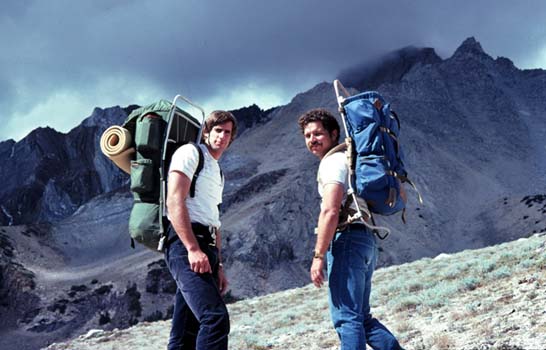 CONDITIONING FOR HIKING AND BACKPACKING
CONDITIONING FOR HIKING AND BACKPACKINGI find the best way to train for hiking and backpacking, is to simply find a good trail near the place you live and get to it. Hopefully, your local trail or trails will have varied terrain that includes some nice hills to hike both up and down on. If you cannot find a trail that has the above features, then you may have to resort to a gym where you can use a stair master or other such piece of equipment.
But I find it best both conditioning wise and health wise to make use of the outdoors if you can. The outdoor air and sunshine is superior to indoor air and artificial lighting (unless you live in a jamb packed city where the air quality is horrendous). Also, the uneven terrain of natural trails works out your ankles, feet, and legs in a way that no machine can duplicate. I also strongly suggest carrying a weighted pack. This is not only a great way to condition for backpacking, but it is also fantastic for getting into shape for hiking without a pack. Doing this will strengthen not only your all important leg muscles, but your feet, ankle, and torso muscles as well. Carrying a pack will also condition your shoulders and upper body. We try to carry at least 10 to 20 pounds more than what we will be carrying in the mountains. This makes it so our pack feels light when it comes to the actual climb or backpack, and we get far greater enjoyment from our adventure.
And when it comes to hiking, carrying a weighted pack is also great. I have to say that after training with a pack, and we then decide to take a day hike up something like Half Dome in Yosemite, or some other daytime excursion, we seem to fly up the trail when unencumbered with a heavy pack.
Jogging, cycling, swimming, and other types of aerobic activities also help, and it is a nice way to change up your training. This way, you don't get bored with the whole thing. But remember the law of "Specificity" above. The closer your training activities are to the actual sport you are engaging in, the faster you will increase performance.
We try to spend an hour or so three times a week hiking, and carrying a pack, and about an hour twice a week cycling if we are planning to go on a backpack or hike. We used to do this for mountaineering too, but we have recently changed our training plans due to the recent knowledge we have gained.
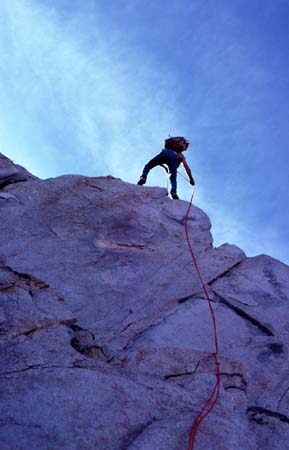 CONDITIONING FOR CLIMBING
CONDITIONING FOR CLIMBINGAs with hiking and backpacking, the best way to condition for climbing, is to actually spend time doing it. But this can become a little more difficult for some of you if you do not have any good natural climbing areas near your home. We are very fortunate to have several fantastic natural boulders and climbing areas with cliffs up to 80 feet to train on. If you do not have anything like this around where you live, you will either have to spend time getting to such a place, or resort to artificial climbing walls. But no matter what, you need to spend most of your training time climbing in order to excel at it.
Climbing also requires good strength, and this involves anaerobic conditioning. I find that a combination of actual climbing, and strength training works best. Fingerboards, pull up bars, pull down machines (at the gym), push ups, and other strength training exercises can really help when it comes to rock climbing or ice climbing.
Rock climbing also requires far more skill than simply hiking or backpacking. Proper gripping, under-clinging, stemming, laybacks, crack climbing, and other such skills, are vital. Balance and positioning are also skills that need to be mastered. Nearly every muscle in your body comes into play when climbing. This is why you need to spend time doing it in order to properly condition for it.
But if you have never climbed, you need to hook up with an experienced friend, or better yet, get some formal expert training in the art of climbing. Rock climbing and mountaineering are inherently dangerous sports, and there is no substitute for hands on experience with a competent instructor.
But as mentioned above, no machine or device can match what you will gain by spending time climbing. However, weight and strength training can help. Especially pull ups and balance type exercises. Climbing can also take a good amount of aerobic endurance, if you engage in big wall climbing such as El Capitan in Yosemite, or if you like to speed climb. But for most climbers, spending a lot of time training aerobically is a waste of time when compared to spending time actually practicing climbing.
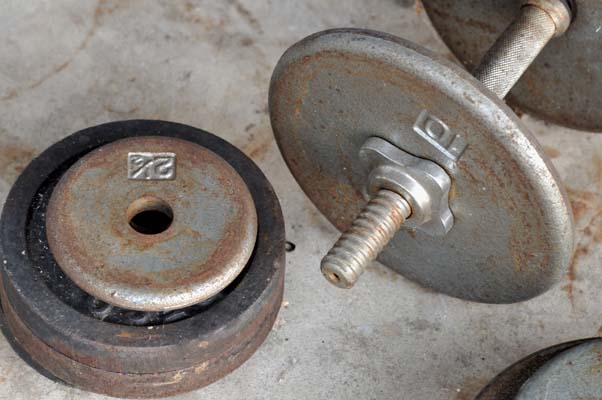 Also, I would like to mention artificial climbing walls vs real life natural bouldering and cliff climbing. Problem solving is crucial to becoming a good rock climber, and if you end up wiring a few climbs on your local artificial walls, you will be limited when it comes to the real thing. I liken it to leaning how to play chess from a book. It works great if your opponent follows the textbook examples you have studied, but as soon as he or she leaves the pattern, you are lost. This works the same way with climbing. If you end up mastering the moves required to excel at your gym's artificial wall, that works fine as long as your intended climb in the wilderness closely matches your wired moves. But if you
get out there, and conditions end up being far different, then you may find yourself performing at a far lower level than what you are used to at the gym. Therefore, try and get as much practice as possible on the real thing. Your body will also condition best this way.
Also, I would like to mention artificial climbing walls vs real life natural bouldering and cliff climbing. Problem solving is crucial to becoming a good rock climber, and if you end up wiring a few climbs on your local artificial walls, you will be limited when it comes to the real thing. I liken it to leaning how to play chess from a book. It works great if your opponent follows the textbook examples you have studied, but as soon as he or she leaves the pattern, you are lost. This works the same way with climbing. If you end up mastering the moves required to excel at your gym's artificial wall, that works fine as long as your intended climb in the wilderness closely matches your wired moves. But if you
get out there, and conditions end up being far different, then you may find yourself performing at a far lower level than what you are used to at the gym. Therefore, try and get as much practice as possible on the real thing. Your body will also condition best this way. The vacation time we set aside these days is usually spent on mountaineering, and conditioning for that will be discussed below. But years ago, I spent lots of time rock climbing at our local climbing area. We usually set aside 2 to 3 hours for climbing at least twice during the weekdays, and possibly 3 to 4 hours of climbing on Saturday mornings. Needless to say, we got in fine shape for climbing during those days, and we gained skills that I still use today. I also did some weight training, and that helped too. If you are new to climbing, then make sure to get hooked up with a good instructor who has plenty of experience. This will be crucial for both your safety and progress in the area or rock, snow, or ice climbing.
So if you want to get the most out of your time spent conditioning for climbing, make sure to set aside 4 or 5 hours each week for climbing, and a few hours a week for strength training. As mentioned earlier, pull ups, fingerboards for grip strength, push ups, and pull down machines help most when it comes to climbing. Becoming a good climber depends on both proper conditioning and skill. And gaining the proper skills will require an additional expenditure of time over just having to condition for a hike. But building your skill set is vital if you want to move your climbing abilities to the next level.
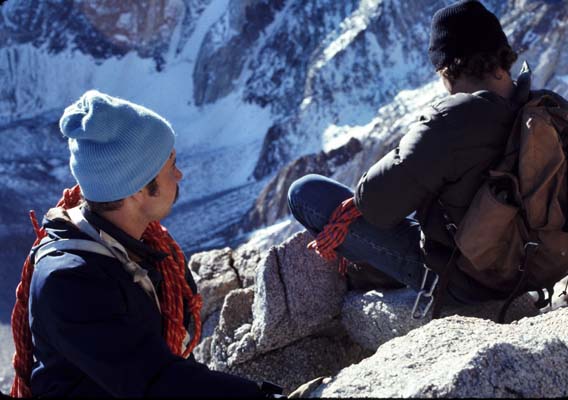 CONDITIONING FOR MOUNTAINEERING
CONDITIONING FOR MOUNTAINEERINGWhen it comes to conditioning for mountaineering, we need to put it all together. You need to train aerobically like for hiking and backpacking, and you also need to do some training for climbing. Hiking and backpacking come into play because you need to get to the base of your intended peak. This can often involve anywhere from a few miles, to very long distances for remote peaks.
There are also times when you will have to call upon your climbing skill in order to attain the actual summit. So the mountaineer needs to train for both endurance and strength for maximum effectiveness. Now I could stop and just say, take all the information from above and combine it, and you will be set for mountaineering, but it is a bit more complicated than that.
The problem with training for mountaineering, is that strength training and aerobic training conflict with one another. To get a mental picture of this, examine the physique of a marathon runner with that of a 100 meter sprint champion. Typically, the marathon runner is extremely thin. This is because the long term aerobic training burns not only fat, but many times ends up burning muscle too. This is because it is nearly impossible to take in enough fuel to maintain muscle mass during all that activity. And to add to this, the marathon runner, (even if he or she could take in enough fuel), it is far better off to maintain low body weight so that they can remain competitive.
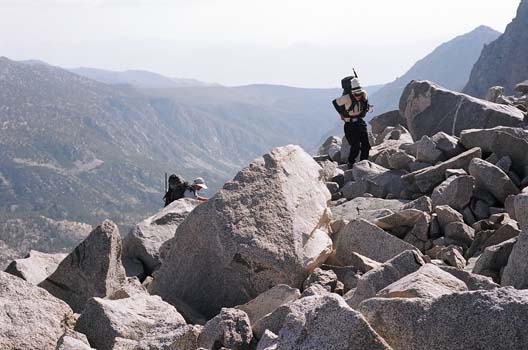 It is very difficult to overcome weight with strength when it comes to maintaining speed over long periods of time and distance. This is why Tour de France champion cyclists maintain a weight of between 150 - 165 pounds. You don't see two hundred pound plus people wining marathons or cycling championships.
It is very difficult to overcome weight with strength when it comes to maintaining speed over long periods of time and distance. This is why Tour de France champion cyclists maintain a weight of between 150 - 165 pounds. You don't see two hundred pound plus people wining marathons or cycling championships. On the other hand, champion sprinters are usually well developed muscle wise because they need explosive power. Not that they are overweight by any means (as mentioned it is hard to overcome weight with strength when it comes to moving your body over any type of distance) but they are usually lean and well developed strength wise.
But the mountain climber needs to be both fit aerobically and strength wise. This is tough, because when the mountaineer is training for greater strength by doing squats, pull ups, push ups, dips, and the like, he or she is likely to be gaining muscle weight, which is then torn down during times of high aerobic output during long distance training. This is why you may notice an ammonia odor after carrying a pack through the hills for two or three hours. Ammonia is a by product of muscle mass being torn down.
These factors as stated above, make it even more important that you take in the proper fuel for your body as you condition. You need to strike that fine balance between, body weight, aerobic fitness, and strength for maximum efficiency.
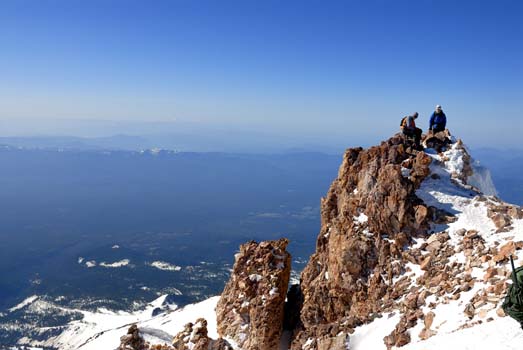 So when it comes to conditioning for mountaineering, you need to remember the following. Specificity still applies. You need to spend time carrying a loaded pack to get into shape for you approach to the peak, walk and hike as much as possible to continue to improve your long distance endurance, and spend part of your time doing strength training exercises and climbing. This will be required if you plan on doing any peaks that require technical skills.
So when it comes to conditioning for mountaineering, you need to remember the following. Specificity still applies. You need to spend time carrying a loaded pack to get into shape for you approach to the peak, walk and hike as much as possible to continue to improve your long distance endurance, and spend part of your time doing strength training exercises and climbing. This will be required if you plan on doing any peaks that require technical skills. If you are planning a mountain climb, you will need at least 12 weeks of conditioning if you do not want to perform at a base level. We try and do the following:
1) Two days during the week of carrying a weighted pack as described in the backpacking section, of approximaately one hour of duration.3
2) Two days a week, of strength training with a home weight set, doing pull ups, dips, and push ups, or going to the gym for all this.
3) Saturday mornings 2-3 hours of climbing on a local climbing wall, or if you are fortunate to have natural boulders and/or rock faces to climb on in your area, use them for training (but remember if you are new to this, get expert instruction). This sounds like a lot, but I believe that it is a minimum if you want to enjoy your mountaineering experience.
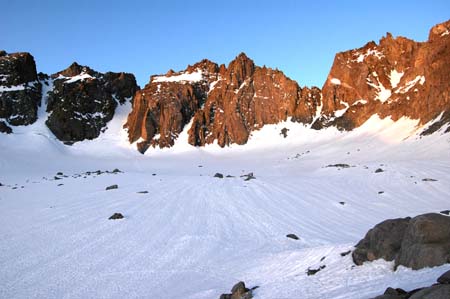 When it comes to mountaineering, you also need to examine the requirements of the particular peak you are planing to climb. Take Mt Whitney for instance. If you plan on taking the trail to the top, or if your mountaineering involves nothing more than packing or hiking up to the summit on a trail, then I would skip most of the strength and specific climbing requirements, and concentrate on the training outlined in the hiking/backpacking section above.
When it comes to mountaineering, you also need to examine the requirements of the particular peak you are planing to climb. Take Mt Whitney for instance. If you plan on taking the trail to the top, or if your mountaineering involves nothing more than packing or hiking up to the summit on a trail, then I would skip most of the strength and specific climbing requirements, and concentrate on the training outlined in the hiking/backpacking section above. And on the same line of thinking, I would not spend a lot of time working on aerobic conditioning, if I planned on doing climbs that involved a mile or two hike to a rock face where I then needed to scale up a technical 100 or 200 foot cliff. There, I would condition as outlined in the rock climbing section. But if I were going to set off to climb North Palisade, which requires packing in, snow and ice work, and rock climbing, I would try and train in all areas, if possible, to give myself the maximum chance for success.
If I had to make a choice though, when it comes to mountaineering conditioning, and I had only time enough for one or the other, I would lean toward aerobic training. Because if you are out of shape aerobically, you will not even make it to the base of the peak. But this assumes that you have climbing skills already. And this only comes from having spent time in the past training and learning the technical skills required to make your assent. If not, then you have no business being on the mountain in the first place. You may end up getting yourself killed.
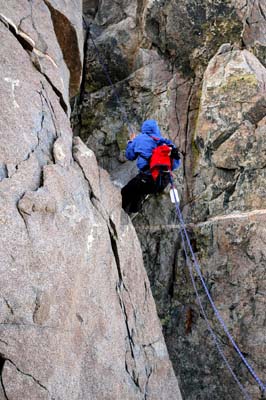 I mention the above, because technical climbing skills stay with you over the years, whereas physical conditioning quickly fades if you decide to get lazy and do nothing over the course of a couple of months or more.
I mention the above, because technical climbing skills stay with you over the years, whereas physical conditioning quickly fades if you decide to get lazy and do nothing over the course of a couple of months or more. Muscle training is very specific, and if you train for aerobics only, you will get very tired when you begin to actually use your hands and arms for scrambling, climbing through a difficult rock section, or engaging in a snow and/or ice climb.
Chopping steps in the ice, anchoring, and other technical activities require good upper body strength and conditioning. I have gone out under both conditions. If I train almost exclusively aerobically, I do great down lower on the trail with my pack. But latter on I can fade out quickly when working through the rock, snow, or ice.
But if I train for both, then I feel great and find that when I reach the summit, I have plenty of strength left over for the descent (which is equally important). COMMON CONSIDERATIONS
I have put this section last, because it is common to all areas of conditioning. We have separated the different activities of hiking/backpacking, climbing, and mountaineering, because they each have their unique considerations, but there is no doubt, that there is a lot of areas where they overlap. So the conditioning and skills you attain in each area, will help you if you decide to switch over and get into some other outdoor activity. So here are a few more things for you to think about.
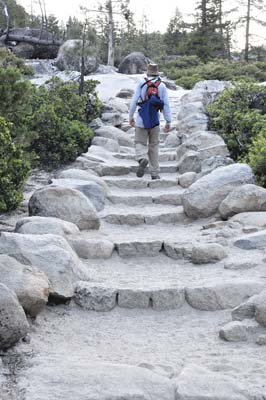 WARMING UP AND COOLING DOWN
WARMING UP AND COOLING DOWNMuscles in their resting state, are a little stiff and the more sedentary the lifestyle the stiffer they become. This becomes even a greater problem as we age. Ignoring a warming up period by jumping right into a heavy exercise regimen, will risk muscles tears, resulting in very painful injuries. To prevent this from happening, muscles need to be warmed up before any major exercise
I find that the best way to warm up is to walk briskly for about 5 – 10 minutes, followed by a few minutes of a stretching routine. Also remember the principle of “specificity.” Concentrate the stretching in the areas that you will be using.
Warming up will raise the temperature of your muscles, making them much more efficient. It will also increase blood circulation which in turn will provide the much needed oxygen to all areas of the body. This in turn improves the energy pathways as we discussed in the beginning. Add to this, reduction of muscle stiffness, and better flexibility of the muscles that results in better contraction and relaxation, and you begin to get the picture.
Taking time to do this makes it so all the critical areas, and the moving parts can heat up a bit. This helps prevent damage to the engine. This is why engine manufacturers tell us that most damage is done to the motor on start ups. This holds true for the human machine too.
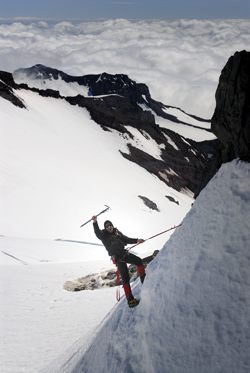 Cooling down works the same way, but only in reverse, and is also extremely important. You are coming off a stiff workout,
and before you just abruptly stop and jump into your vehicle, take some time to slow down by hiking, or walking about for 5 – 10 minutes or so, followed by some additional stretching. The cooling down period is important to help the heart fall back into its normal beating pattern. Cooling down will also help your muscles to remove waste products which could otherwise lead to spasms and those uncomfortable cramps known as “charlie horses.” And finally, and possibly most importantly, it allows for the gradual reduction in adrenaline that will facilitate the body’s ability to return to a relaxed state.
Cooling down works the same way, but only in reverse, and is also extremely important. You are coming off a stiff workout,
and before you just abruptly stop and jump into your vehicle, take some time to slow down by hiking, or walking about for 5 – 10 minutes or so, followed by some additional stretching. The cooling down period is important to help the heart fall back into its normal beating pattern. Cooling down will also help your muscles to remove waste products which could otherwise lead to spasms and those uncomfortable cramps known as “charlie horses.” And finally, and possibly most importantly, it allows for the gradual reduction in adrenaline that will facilitate the body’s ability to return to a relaxed state. So make sure to take a little time out to warm up and cool down. If you ignore these principles, you may be setting yourself up to suffer muscle and heart damage for both the short run and even worse, for the long run. Again, this holds even more true as we age.
Lastly, it would also help if you take some antioxidants like vitamin C and E after exercising. Conditioning creates free radicals in your system, and they are very oxidative by nature. Antioxidants work to neutralize the harmful effects of free radicals.
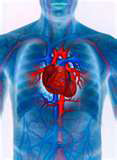 HEART MONITORS
HEART MONITORSHeart monitors can be very helpful for training in the beginning. They work great for keeping you in certain "training zones." To make use of them you need to know your maximum heart rate. The average person can calculate this by starting off with 220 and subtracting their age. This is certainly not fool proof and it can have a 10% error factor or more, especially for older people who are in great shape. The formula will underestimate their maximum heart rate. And the same thing goes when using it to estimate your maximum heart rate if you are young and in very poor condition.
For Aerobic training, you will want to keep your heart rate in the 50 to 70 percent range of maximum. For anaerobic training, you will want to keep it in the 70 - 90 percent range. If you are working toward long distance endurance, you will want to train in the 50 - 70 percent range. This range is also perfect, if you want to loose weight. If you are a sprinter and are working for explosive power over a series of boulders or the like, then you will want to do some interval training. Interval training is where you run hard, or climb fast to the point of getting your heart rate up to the 80 or possibly even 90 percent range, and then holding it there for a few minutes. This is also good training to raise your lactic acid threshold as discussed above.
IMPORTANT NOTE:
Before starting on any exercise or conditioning program, check with your doctor. Especially if you have any heart or lung problems, or feel any abnormal symptoms when you exercise. This is especially true if you are over 40 years of age. Interval training can be especially dangerous if you are not used to it or pre-conditioned for it. OVER-TRAINING
Keeping track of your heart rate can also be very valuable when it comes to over-training. The fastest way to know if you are over-training, is to check your resting heart rate when you first get up in the morning. At anytime during your training regimen, you find that your resting heart rate has increased 10 or more beats per minute, than you are over-training. Over-training is counter productive and you need to slow down. Symptoms of this can also be noticed when you feel tired more often than not, and you find yourself exhausted in the morning. Proper training should lower your resting heart rate and you should have more energy than ever. If not, than you need to cut back your training activities (or get to bed on time), and rethink your conditioning program.
 MENTAL CONDITIONING
MENTAL CONDITIONINGThis topic is so huge that it really deserves a complete page all it's own. One of the many incredible things about mountaineering is that you see the effects of emotions being played out in very short periods of time. Fear and negative emotions have such a terrible effect on performance and bodily function, that people who say that the way they think has little or no effect on how they behave or function in life both on the physical and mental plane almost becomes laughable. The mind has an incredibly powerful impact on what chemicals and hormones are released into our body. Fear, anger, joy, and all the other various emotions, can create either a sense of well being or a sense of hopelessness. It depends on what we dwell on. This being true, we need to keep a tight reign on our thought process.
I have watched people work themselves into the jitters and literally defeat themselves by the things they were thinking and saying, before they even placed one foot on the rock. And this can be true even when doing something as simple as hiking, because I witnessed my son do it to himself. One day while hiking on one of the local trails, he began going so slow that I thought we were going to have to spend the night out on the open ground in the hills. He told me he was exhausted, but the truth of the matter was that he was angry with mom. After a discussion on the matter, he changed his thinking and got up and hiked out of those hills at warp speed.
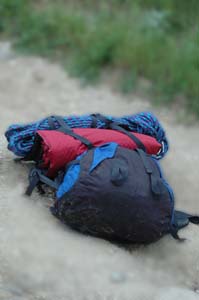 It's also amazing to watch little ones run around with boundless energy in the play yard and then become utterly exhausted after walking up the trail just a few hundred yards. This most often is because of the mental. They see their destination looming in the distance and begin thinking that they will never get there. I find this can plague young folks even in their twenties. But with enough experience they eventually find that if they just keep putting one foot in front of the other they will eventually get there.
It's also amazing to watch little ones run around with boundless energy in the play yard and then become utterly exhausted after walking up the trail just a few hundred yards. This most often is because of the mental. They see their destination looming in the distance and begin thinking that they will never get there. I find this can plague young folks even in their twenties. But with enough experience they eventually find that if they just keep putting one foot in front of the other they will eventually get there. This is why hiking with a headlamp on early alpine starts, or working your way up to a base camp at night works great. In the dark, there are very few mental distractions and it seems that you don't wear down as much mentally. Thus, you perform better.
Young people also have a tendency to go way to fast. This burns up all their glycogen reserves. They then "hit the wall," and are done for the day. They need to gain the experience (and restraint), to pace themselves so they can perform steady all day. It usually takes more than a day to recover if you "hit the wall." Your performance will also suffer the next day, and if you burn up the track again, you will just continue to perform worse and worse.
And lastly, do not entertain negative thoughts. Dwelling on things such as anger, unforgiveness, bitterness, failure, fear, and a whole host of other harmful emotions will not only ship wreak your performance in the mountains but it will also do you in when it comes to everyday life. Make no mistake about it, incorrect thinking will add a ponderous amount of weight to your pack. So lighten your load by casting off all that negative and you will find yourself scaling the highest peaks in life.
 I DON'T HAVE TIME TO CONDITION OR EXERCISE
I DON'T HAVE TIME TO CONDITION OR EXERCISEAs I mentioned in the beginning, I am giving you some guidelines to help you condition to a level that will enable you to enjoy your time in the wilderness.
Naturally, if you want to become a renowned climber, extreme long distance backpacker or hiker, or legendary mountaineer, you will have to live and breath your sport of choice. Training then becomes a full time project. But most of us are recreational outdoor enthusiasts and our time for conditioning is limited.
The American College of Sports Medicine reports that you need to spend 30 minutes 5 - 6 times a week exercising for 30 minutes to maintain a minimum amount of fitness for good health. But few people want to take even thirty minutes out of their day.
So what do you do if you are pressed for time and want to maintain some degree of fitness? Well, you need to make the most of every opportunity. I take a brisk 2 mile walk almost every day during my lunch break at work. It only takes me about 25 minutes or less to do so, and it adds up to 10 miles of walking each week. That's 520 miles a year!
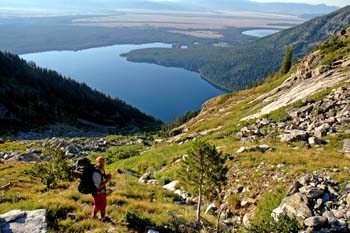 Next, don't sweat having to park your vehicle in some distant location. I never worry about parking close to my destination. And placing my vehicle in that wide open out of the way spot makes for easy parking. Most people hate having to walk those few extra steps and end up fighting for and/or wasting lots of time and gas circling around and around so that they can get that up front location. But I see it as an opportunity to get some extra exercise. Many times I find myself well into my shopping routine while that individual outside continues to circle round and round.
Next, don't sweat having to park your vehicle in some distant location. I never worry about parking close to my destination. And placing my vehicle in that wide open out of the way spot makes for easy parking. Most people hate having to walk those few extra steps and end up fighting for and/or wasting lots of time and gas circling around and around so that they can get that up front location. But I see it as an opportunity to get some extra exercise. Many times I find myself well into my shopping routine while that individual outside continues to circle round and round. Taking the stairs rather than the elevator is another good way of getting in some extra exercise. Stair climbing is a super way to get into shape. I try and use the stairs even if it means climbing up 10 flights of them in a large parking structure like "The Grove" in Southern California. And just like with the parking, I often find that I reach my destination in less time than the crowd down below who are still waiting for the elevator.
When the weekend comes, you will find that you are in "not half bad shape" and will be able to go on an enjoyable mountain bike ride or take a beautiful local hike. The body reacts best to consistency, so don't make excuses for why you cannot exercise. Again, learn to take advantage of every opportunity like the examples above. It all adds up. Not only will you get in better shape over time, but it will also relieve stress when you don't have to worry about some rude person taking your parking spot.
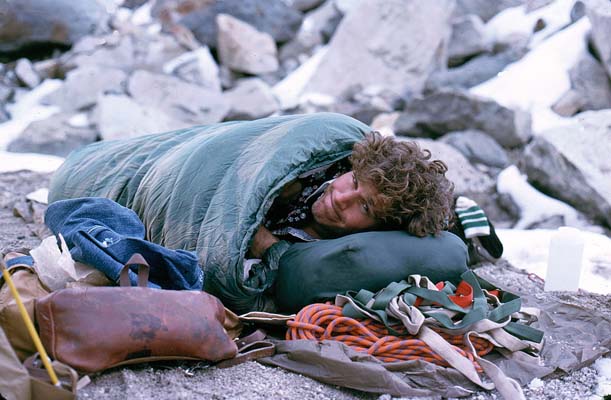 BENEFITS OF EXERCISE / CONDITIONING
BENEFITS OF EXERCISE / CONDITIONINGThere are many benefits to exercise and conditioning. Here is just a sampling of some of them:
1) Better heart and lung performance. Aerobic exercise improves the efficiency of the muscles you breath with. Thus you will need to take in fewer breaths for any given amount of work you have to do.
2) Stroke volume improves making it so your heart does not have to work as hard. You will notice this as your resting pulse rate begins to lower. This will enable you to hike up hills without having your heart pounding like a big base drum.
3) You improve your lactic acid threshold so that you will be able to perform longer and at a higher intensity before having to come to a complete halt.
4) Helps to produce a feel good attitude. Being physically active releases endorphins, the body's "feel good" hormones. This also is of great help, if you battle depression.
5) Exercising helps relieve stress.
6) Helps you to fall asleep faster and sleep deeper.
7) Regular physical activity can help you prevent — or manage — high blood pressure. Your cholesterol will benefit, too. Regular physical activity boosts high-density lipoprotein (HDL), or "good," cholesterol while decreasing triglycerides. This one-two punch keeps your blood flowing smoothly by lowering the buildup of plaques in your arteries. And there's more. Regular physical activity can help you prevent type 2 diabetes, osteoporosis and certain types of cancer. (Info from the Mayo Clinic)
8) Greatly helps when it comes to managing your weight and also boosts bone strength.
9) It's a great way to spend some time together as a family.
10) Walking on different terrains provides even greater health benefits than walking on only flat surfaces. According to Dr. Heinz Drexel from the Vorarlberg Institute in Feldkirch, Austria, individuals who spent three to five hours a week either walking up or walking down the slope of a mountain enjoyed improved triglyceride metabolism on their way up the mountain, and improved glucose processing on their way down. This plays out big time when it comes to good health.
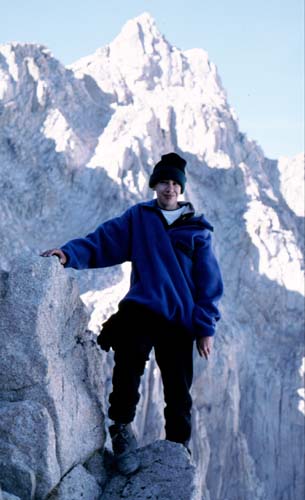 CONCLUSION:
CONCLUSION:A) Conditioning is vital when it comes to outdoor activities such as backpacking, longer distance hikes, climbing, and mountaineering. Without it, you will find yourself just going through an exercise in pain.
B) Learning a bit of the science behind how the body works will encourage you to train properly. It will also help you mentally if you understand what your body is going through.
C) "Specificity" applies directly to your conditioning program. Meaning that most of your training time needs to be spent doing your particular sport or activity of choice. If climbing, then climb, if hiking, then hike. Etc.
D) Proper nutrition, sleep, warm up and cool down procedures need to be adhered to in order to reduce your risk of injuries and be able to get the most out of your training program. This becomes even more important as you age.
E) Rock Climbing, Snow and Ice Climbing, and Mountaineering, are inherently dangerous sports, and good technical skills are required for both safety and proficiency. If you are new to climbing or mountaineering, then expert instruction is a must.
F) Heart Monitors are very helpful for enabling you to "stay in the zone" when conditioning. They also assist you in avoiding the syndrome of "Over Training" which in the end does more harm than good.
G) Mental and emotional fitness, I believe, makes up the most important part of all endeavors in life. Dwelling on past unpleasant memories, failures, criticism, future "what ifs," feelings of doubt, or any other list of negative emotions will work to defeat your every goal in life, if you let them get the best of you. When "Mr Negative" comes knocking at your door, don't entertain him. Treat him like you would a small burning ember in your home. Put it out before it burns your mental house down.
H) Stop making excuses for not exercising. There are plenty of ways, even during the course of you everyday activities, to get some conditioning in.
Exercise and conditioning have many benefits for both your mental and physical well being. Many doctors call it the magic bullet when it comes to good health. So as the above states, stop making excuses and get to it!
 DEEPER INSIGHT -
DEEPER INSIGHT - The most important way to Condition. Conditioning for activities that require strength and endurance such as mountaineering is crucial if you want to perform at your best and enjoy the many beauties of the outdoors. But the above will require time and commitment. This principle also holds true with just about anything worthwhile in life.
An example would be preparing for success in a future career. Things like apprenticeships, certifications, advanced degrees, and such, are very important when it come to securing a good paying job. But they all require time and commitment. Other examples would be things like a good marriage, strong family bonds, maintaining a nice home, a backyard garden, and so on, also require time.
But as important as all the above is, there is something even more important for us to consider when it comes to the investment of our time, and that is this: "What kind of time do we spend conditioning for eternity?" You see, if you could imagine a rope, representing a time line, beginning from where you are sitting and then extended all the way out to the furthest point of the universe, then you would get a tiny picture of the amount of time it takes to make up eternity. It's endless! Now lets take a look at the end of the rope that begins at where you are sitting. The first 1/4 inch of length is colored red and the rest of it is all white. That first 1/4 inch of rope represents your time here on earth. The Bible describes that first quarter inch of rope as follows:
"LORD, make me to know my end, and what is the measure of my days, that I may know how frail I am. Indeed, You have made my days no longer than my hand, and my age is as nothing before You; each mans life is but a vapor. Psalm 39:4-5
What is your life? You are a mist that appears for a little while and then vanishes. James 4:14b
Do you begin to get the picture?
We endure conditioning and training, and spend time doing it, because we feel the end result of better health and performance in the mountains is worth it. Or we endure pain and suffering on some distant peak, because we feel the summit is worth the effort. This again holds true when it comes to anything we spend time and effort on. But what kind of value do we place on how and where we will be spending all that time left over once we exhaust the first 1/4 inch section of rope?
It is nothing short of mind boggling to think of all the time we spend trying to secure ease, comfort, and pleasure here on earth, and then forget about all that is to come.
Now if you have any concern about the above, then you really need to consider the following. You have seen it at football games, you have heard it quoted, and now would be a really good time to take a hard look at what Jesus is trying to tell you. You just may want to begin a conditioning program to train for a future event you cannot avoid. ETERNITY!
"For God so loved the world, that he gave his only begotten Son, that whoever believes in him should not perish, but have everlasting life. For God did not send his Son into the world to condemn the world; but that the world through him might be saved. John 3:16-17 Email Sign Up
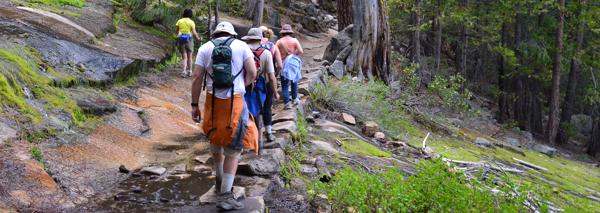
| Join the Adventure! Sign up here for Timberline Trails Monthly Newsletter |

Join us on Instagram

©2006-2024 TimberlineTrails. All Rights Reserved.
....